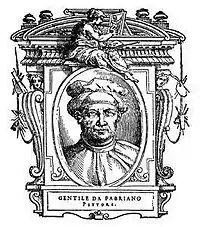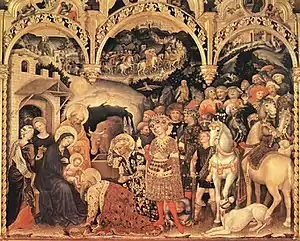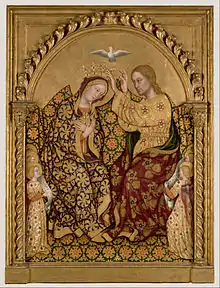Gentile da Fabriano
Gentile da Fabriano[lower-alpha 1] (c. 1370 – 1427) was an Italian painter known for his participation in the International Gothic painter style. He worked in various places in central Italy, mostly in Tuscany. His best-known works are his Adoration of the Magi from the Strozzi Altarpiece (1423), and the Flight into Egypt. Following a visit to Florence in the 1419, he came in contact with humanism, which influenced his work throughout the rest of his career.[4] He became highly influential for other painters in Florence, especially because of his use of detail based on the observations he made of the natural world.[5]
Gentile da Fabriano | |
|---|---|
 Gentile da Fabriano, in a portrait by Giorgio Vasari | |
| Born | Gentile di Nicolò di Giovanni c. 1370 |
| Died | 1427 (aged 56–57) Rome, Papal States |
| Nationality | Italian |
| Known for | Painting |
Notable work | Adoration of the Magi |
| Movement | International Gothic |
Life and career

Gentile was born in or near Fabriano, in the Marche. His mother died some time before 1380, and his father, Niccolò di Giovanni Massi, retired to a monastery in the same year, where he died in 1385.[6] Little is known of his formation: one of his first known works, a Madonna and Child (c. 1395–1400, now in Berlin) shows the influence of the northern Italian late-Gothic painting.[7][8]
By around 1405, Gentile da Fabriano was working in Venice.[9] He painted a panel for the church of Santa Sofia, now lost; Jacopo Bellini worked perhaps in his workshop. Between 1408 and 1409, he painted a fresco (now lost) in the Doge's Palace depicting the naval battle between the Venetians and Otto III. In Venice he knew Pisanello and perhaps Michelino da Besozzo.[9] He also produced commissions for other cities during this period, such as his Madonna and Child for a church in Perugia.
In 1410–1412 he painted one of his first masterworks, the Valle Romita Polyptych (now at the Pinacoteca di Brera). In 1410–1411 he was at Foligno, where he frescoed the Palazzo Trinci. In 1414 he moved to Brescia, at the service of Pandolfo III Malatesta, and painted the Broletto Chapel, a work now mostly lost. In the Spring 1420 he was again in Fabriano.
Florence

On 6 August 1420 he was in Florence,[9] where he painted his famous altarpiece depicting the Adoration of the Magi (1423), commissioned by Palla Strozzi.[10] Which is now in the Uffizi and regarded as one of the masterpieces of the International Gothic style. His other works in Florence include the Quaratesi Polyptych (May 1425) and the Intercession Altarpiece. In June–August 1425 he was in Siena, where he painted a Madonna with Child, now lost, for the Palazzo dei Notai on Piazza del Campo. Until October he was in Orvieto, where he painted his fresco of the Madonna and Child in the Cathedral. In 1427 he arrived in Rome, commissioned by Pope Martin V to decorate the nave of the Basilica of St. John in Lateran, which was completed by Pisanello after his death.
Gentile is known to have died before 14 October 1427. He is commonly said to have been buried in the church now called S. Francesca Romana in Florence, but his tomb vanished; there is evidence, however, that he may be buried in the church of Santa Maria in Trastevere, in Rome, the place of his death.
He left no works in the Marche, except possibly a Madonna and Child (of uncertain attribution) in the Duomo at Sant'Angelo in Vado, near Urbino. He also left one painting in Venice.
Islamic Influence: Mamluk Metalwork
The Mamluk Sultanate is well-known for its production of metalwork objects, most of which include inscriptions in Arabic script.[11] By the late thirteenth century, artists like Duccio and then later in the early fifteenth century, Gentile da Fabriano, were influenced by these types of Mamluk metalwork pieces and started to incorporate their patterns and motifs into their paintings.[12] In Gentiles da Fabriano's Adoration of the Magi (1423), pseudo-Kufic Inscriptions line the cloaks of several figures.[11] Pseudo-kufic inscriptions also appear in the bold, ornamented halo of the Virgin Mary and Joseph, which are divided into four equal parts by rosettes, are also seen in the Mamluk plates.[13] An example of a Mamluk plate of the time is the Mamluk Philae Dish (c. 1345-1360), where four rossetts divide the Arabic script into quadrants.[14]
Halos with pseudo-kufic inscriptions are reflected in several of Gentile da Fabriano’s paintings that were produced during his time in Florence including: Coronation of the Virgin (Gentile da Fabriano) from around 1420 and a Madonna with Child and Angels that is part of the Quaratesi Polyptych (May 1425). Moreover, Gentile da Fabriano’s use of halos with pseudo-kufic inscriptions influenced other artists, including painter Masaccio, who began his use of pseudo-kufic halos as early as 1422, and can be seen later in his Pisa Altarpiece from 1426. Venice was among the early important centers of trade for Islamic goods in Europe, and in turn, traditional Islamic forms were highly desired by European patrons because of their associations with “exotic” Other of Jerusalem and the Holy Land.[15] Halos painted with patterns based on Mamluk metalworks reveal the types of commercial and artistic exchanges that were taking place in other Italian city-states, like Florence.[16] The fact that Florence secured two major seaports, Pisa and Livorno, in 1406 and 1421 respectively, illustrates the increased diplomatic ties between the Florentines and Mamluks.[16]
Notes
References
- "Gentile da Fabriano" (US) and "Gentile da Fabriano". Oxford Dictionaries UK English Dictionary. Oxford University Press. n.d. Retrieved 1 June 2019.
- "Gentile da Fabriano". The American Heritage Dictionary of the English Language (5th ed.). HarperCollins. Retrieved 1 June 2019.
- "Gentile da Fabriano". Merriam-Webster Dictionary. Retrieved 1 June 2019.
- Panczenko, Russell (1983). "English Summary of Gentile da Fabriano and Classical Antiquity". Artibus et Historiae. 4 (8): 167–68.
- "Gentile da Fabriano".
- Wohl, Hellmut (2003). "Gentile (di Niccoló di Massio) da Fabriano".
- "Biographie et œuvre de Gentile da Fabriano (v. 1370-1427)". www.rivagedeboheme.fr (in French). Retrieved 15 January 2022.
- Vasari, Giorgio (2008). Lives of the Most Eminent Painters Sculptors & Architects. London: Philip Lee Warner. pp. 107–117.
- "English Summary". Artibus et Historiae. 4 (8): 167–68. 1983.
- Mack, Rosamond E. Bazaar to Piazza: Islamic Trade and Italian Art, 1300-1600. University of California Press. p. 65. ISBN 0520221311.
- Christian, Kathleen (2017). European Art and the Wider World 1350-1550. Manchester University Press. pp. 29–33.
- Mack, Rosamond E. Bazaar to Piazza: Islamic Trade and Italian Art, 1300-1600. University of California Press. pp. 63–65. ISBN 0520221311.
- Mack, Rosamond E. Bazaar to Piazza: Islamic Trade and Italian Art, 1300-1600. University of California Press. pp. 63–65. ISBN 0520221311.
- "Mamluk Philae Dish". The MET.
- Christian, Kathleen (2017). European Art and the Wider World 1350-1550. Manchester University Press. pp. 29–33.
- Christian, Kathleen (2017). European Art and the Wider World 1350-1550. Manchester University Press. pp. 29–33.
Sources
- Mack, Rosamond E. (2001). Bazaar to Piazza: Islamic Trade and Italian Art, 1300–1600. University of California Press. ISBN 0-520-22131-1.
- Gentile da Fabriano e l'altro Rinascimento, catalogo della mostra (in Italian). Fabriano: Electa. 2006. Exposition lasting 21 April–23 July 2006.
- Marcelli, Fabio (2005). Gentile da Fabriano (in Italian). Silvana.
- De Marchi, Andrea (1992). Gentile da Fabriano. Un viaggio nella pittura italiana alla fine del gotico (in Italian). Federico Motta (published 2006).
- Łada, Justyna (2004). Obraz Maryi z Dzieciątkiem Gentile da Fabriano jako przykład typu Madonny (in Polish). Roczniki Humanistyczne KUL.
External links
| Wikimedia Commons has media related to Gentile da Fabriano. |
- Gentile da Fabriano biography-paintings-curiosity-publications
- Italian Paintings: Sienese and Central Italian Schools, a collection catalog containing information about Fabriano and his works (see index; plates 34-35).
- 5 paintings of Gentile da Fabriano
- Gentile da Fabriano at the National Gallery of Art, Washington DC